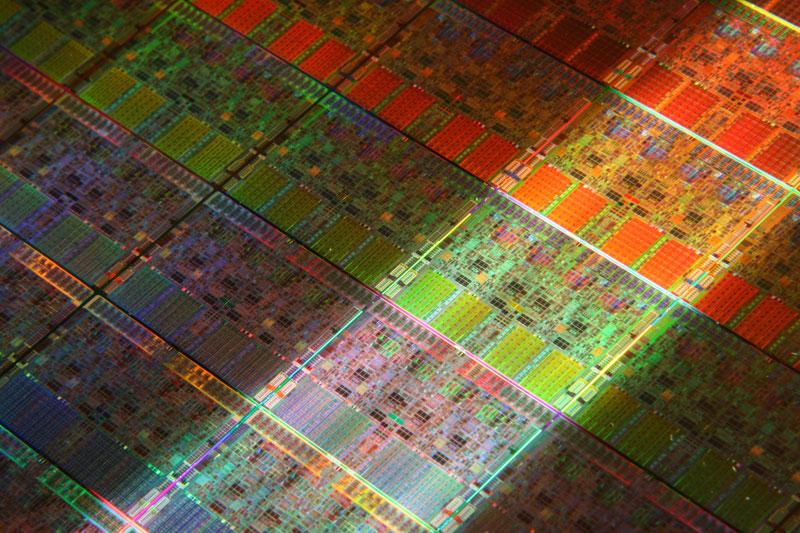Intel this week offered its first official overview Nehalem, the highly scalable microarchitecture positioned to succeed Penryn in delivering a new generation of processors for notebooks, desktops, and servers, that offer "dramatic" energy efficiency and performance improvements.
The leap in performance and energy efficiency offered by Nehalem will be similar to the jump made by Intel's Core microarchitecture over the first 90-nanometer (nm) Pentium M processors, according to company vice president Pat Gelsinger. Key to this, he said, is simultaneous multithreading (SMT), an advanced version of hyper-threading that will create a new dimension in parallelism by enabling a single processor core to run two threads at the same time.
With Intel's plans for Nehalem calling for chips with 1 to 8 (or more) cores, this means a quad-core processor could run eight threads simultaneously, and similarly, an octo-core version up to sixteen threads simultaneously. Depending on the application, the resulting performance boost over today's Penryn chips could be as much as 20 to 30 percent, according to the chipmaker. At the same time, the ability to run more instructions in a single clock cycle allows the processor to return to a low-power state more quickly, therefore also boosting power efficiency.
Nehalem processors will also utilize a new point-to-point processor interconnect called Intel QuickPath Interconnect, which will serve as a replacement for the legacy front side bus (FSB). Instead of using a single shared pool of memory connected to all the processors in a server or high-end workstation through FSBs and memory controller hubs, most Nehalem processors will pack their own dedicated memory that will be accessible directly through an Integrated Memory Controller on the processor die itself.
In cases where a processor needs to access the dedicated memory of another processor in a multi-processor system, it can do so through the QuickPath interconnect that links all the processors. This improves scalability and eliminates the competition between processors for bus bandwidth, according to Gelsinger, as there is no longer a single bus for which multiple chips would need to contend in order to reach memory and I/O services.
A close-up of a Nehalem processor wafer.
Nehalem will also offer the option for an integrated graphics controller for highly efficient mobile designs, and add an inclusive shared L3 (last-level) cache that can be up to 8MB in size. In addition to being shared across all cores, the L3 cache can increase system performance while reducing traffic to the processor cores.
Other features discussed by Gelsinger during this week's Nehalem architectural briefing include support for DDR3-800, 1066, and 1333 memory, SSE4.2 instructions, 32KB instruction cache, 32KB Data Cache, 256K L2 data and instruction low-latency cache per core and new 2-level TLB (Translation Lookaside Buffer) hierarchy.
The majority of these advancements are pertinent to Apple, as the company's ongoing Mac roadmap implies that it will at the very least adopt both server and mobile variants of Nehalem, beginning with a Xeon-based successor to the Harpertown chip presently powering its Mac Pro line of professional desktop systems.
 Katie Marsal
Katie Marsal














 Charles Martin
Charles Martin
 Amber Neely
Amber Neely


 Sponsored Content
Sponsored Content
 AppleInsider Staff
AppleInsider Staff
 Malcolm Owen
Malcolm Owen
 Oliver Haslam
Oliver Haslam








48 Comments
Sounds like these babies will fly.
It also looks like the best chance for Apple to go ahead and release major redesigns of the hardware. Cooling is affected and several components are moved around.
If ever there was a chance for a redesign of the laptops and Mac Pro, IMHO this is it.
What is the theoretical limit in chipmaking (in nm; currently at 45 nm)?
yeah, this is great news, I'm so excited I can't hide it! yeah yeah, great news for video editing & power hungry people like myself.

oh zunx, no way, they are already talking 32 nm and check out Moore's law, here.
What is the theoretical limit in chipmaking (in nm; currently at 45 nm)?
Ha ha. I'd like to hear the answer to that one!
I know that +/-10 years ago the absolute theoretical physical limit was 100nm. With the properties of light and all, it would be impossible to get below that. What would happen to Moore's Law? everyone wondered.
I don't think it matters what the best brains might think now, everything will be different in 10 years!
What is the theoretical limit in chipmaking (in nm; currently at 45 nm)?
The next node is 32 nm, which we will see in 2009 (maybe late 2008). The one after that, which Intel is working on is 22 nm, which, if everything comes out all right, will be here, possibly in 2010.
22 nm is going to be interesting because the tools to do the lithography haven't been finalized as yet. At these small sizes, lithography becomes the most difficult part, other than the need to be able to hold the features to a much closer tolerance.
After 22 nm comes 15, which, right now, is not possible, as the litho tools won't work at that size.
But, they have been working on numerous methodologies, such as x-rays.
After that is about 10 nm, which is being argued. Some scientists, and engineers, aren't sure if we can do 10 nm at all.
If not, perhaps carbon nanotubes can be used. IBM and Hp have shown work with those that show promise, but it's thought that a production process, if possible, won't come for about ten years.
There are other technologies under investigation as well, such as protein storage, etc.
And, of course, there's optical, an area in which there have been several breakthroughs recently, by IBM, for one.